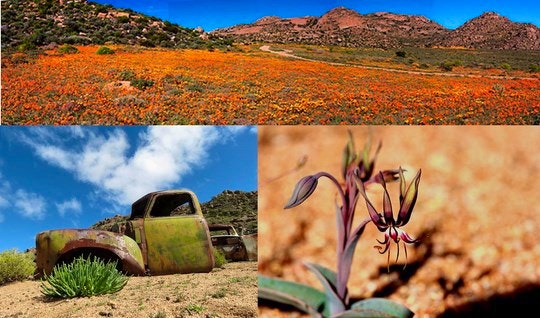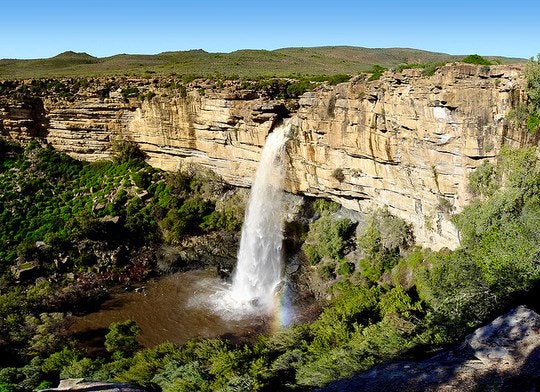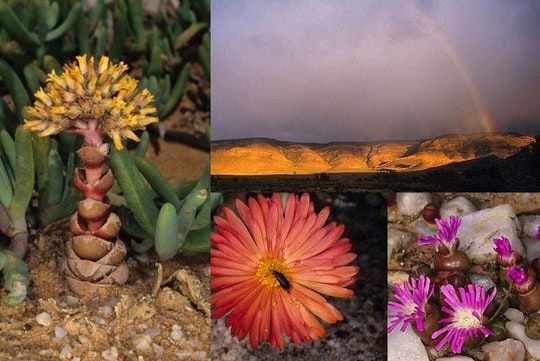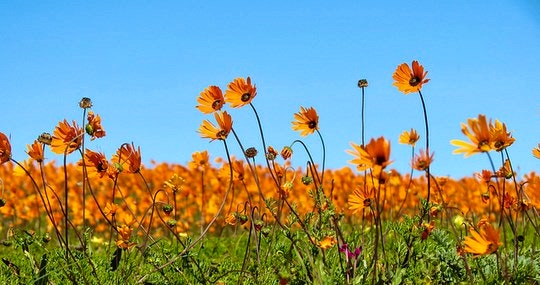With the first rains of spring, the dry, dusty plains of South Africa’s “outback” are magically transformed into a carpet of colour as the Namaqualand wild flowers burst to life. Almost overnight, the normally drab semi-desert of the Northern Cape is suddenly covered in millions of cheerful flowers, which last from early August to late September. And contrary to popular belief – it isn’t just a bunch of daisies! Although most wild flowers tours are booked up months in advance, you can enjoy a picturesque self-drive to Namaqualand up the N7 from Cape Town or along the N14 from Johannesburg.
The Namaqualand is a vast area of the Northern Cape, bordered by Namibia and the Orange River to the north, and the rugged, ship-wrecked coastline of the Atlantic Ocean to the west. It is a land of contrasts with a harsh climate that has created a myriad of life forms superbly adapted to their specific habitat. Every turn in the road paints an unforgettable picture of daisy-filled valleys, enormous granite outcrops, flittering birds and butterflies, eye-catching succulents and quiver trees, starry skies, wildlife, and the roaring Atlantic Ocean.
The flowers don’t have to be appreciated from your car alone. There are several hiking and cycling trails, such as those in the Goegap Nature Reserve, that allow close scrutiny of the indigenous flora.

Tips for viewing the Namaqualand wild flowers
- The flower season peaks between early August and late September and it is dependent on the winter rains and spring temperatures. Some years are better than others!
- As a general rule of thumb, the wild flowers first begin flowering in the Namqualand in late July/early August and then advance southwards through Nieuwoudtville and the Cedarberg towards the West Coast in late august/early September. To avoid missing the display, travel north quickly and then take your time viewing the flowers as you travel south.
- The flowers are at their best between 10h30 and 16h00.
- Unfortunately the flowers won’t come out in heavily overcast or rainy weather, so have a sightseeing plan B if the weather turns grey.
- The displays are noticeably better if the flowers are facing you, so travel with the sun behind you. When planning your daily route, try to travel in a westerly direction in the morning, south during the day, and east in the afternoon.
- You can walk amongst the flowers, but you are not allowed to pick them.
- Make sure you have plenty of spare batteries for your camera, because the photographic opportunities are endless.
Places of Interest
- Nieuwoudtville: Known as the place of hidden treasures, Nieuwoudtville boasts the biggest variety of indigenous bulbous plants (500,000) in the world. Other sights include the Glacial Rock Striations which date back 280 million years; the 100m high Nieuwouldville Falls on the Doring River; and the quiver tree forest, which is the largest and southernmost colony of Aloe dichotoma.

- Skilpad Wild Flower Reserve: Situated in a mountainous area about 25km from Kamieskroon, Skilpad incorporates a shrubland and abandoned wheatlands. It has recently been incorporated into the Namaqua National Park and should not be missed.
- Springbok: Enjoy the amazing display of flowers and rock formations, and discover the interesting copper mine history of Springbok.
- Goegap Nature Reserve is a 12,000 ha wildflower reserve outside of Springbok where you can pack a picnic, visit the Hester Malan Wild Flower Garden, and drive a scenic 17km route.
- Knersvlakte: This wasteland is home to the richest succulent populations on earth.

- Alexander Bay: The largest and most important town in Namaqualand, Alexander Bay lies at the border of Namibia and is famous for its diamond mines. The world’s largest lichen field can be found on a hilltop to the east of town, and there is a wonderful bird sanctuary on the Orange River estuary.
- Port Nolloth: A small harbour town and holiday resort, Port Nolloth is especially popular for its excellent line-fishing and crayfish industry.
- Ramskop Wild Flower Garden: Situated near Clanwilliam in the Western Cape, Ramskop is one of the best displays of wild flowers in South Africa.
- Clanwilliam Flower Show: Held at the end of August every year, the fascinating Clanwilliam Flower Show exhibits about 400 species in their typical setting.
- Postberg Nature Reserve: Set within the West Coast National Park, the reserve boasts the greatest variety of birds, game, and Sandveld flowers in the Western Cape.
Don’t miss this natural phenomenon! Browse our Namaqualand accommodation today and start planning your road trip to see one of the world’s finest flower displays.
Images by Chris Preen, Derek Keats, coda, and mmmavocado





